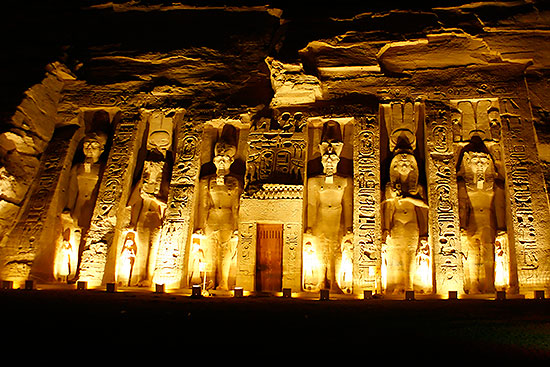Abu Simbel
Abu Simbel is a temple built by Ramses II (c.1279-1213 B.C.E.) in ancient Nubia, where he wished to demonstrate his power and his divine nature. Four colossal (65 feet/20 meters high) statues of him sit in pairs flanking the entrance. The head and torso of the statue to the left of the entrance fell during ancient times, probably the result of an earthquake. This temple faces the east, and Ra-Horakhty, one manifestation of the sun god, is shown inside the niche directly above the entrance. The alignment of the temple is such that twice a year the sun’s rays reach into the innermost sanctuary to illuminate the seated statues of Ptah, Amun-Ra, Ramses II, and Ra- Horakhty.
The temple was cut out of the sandstone cliffs above the River Nile in an area near the Second Cataract. When the High Dam was being constructed in the early 1960s, international cooperation assembled funds and technical expertise to move this temple to higher ground so that it would not be inundated by the waters of Lake Nasser.
Sunk Relief of the God Hapy
At Abu Simbel, below the seat of one of the colossal statues of Ramses II (c.1279-1213 B.C.E.), is the sunk relief of the god Hapy, the personification of the Nile flood. The figure of Hapy appears twice, tying stems of plants around the hieroglyph for “unite.” The extended foot of each Hapy figure rests on the hieroglyph which is a lung from which a windpipe projects straight up from the center, forming a “T” at the top. On the left Hapy holds stems of the lotus (symbol of Upper Egypt); on the right he holds stems of the papyrus (Lower Egypt). Hapy’s crowns also display these plants. Hapy is androgynous (both male and female characteristics), suggesting the fertility of the land which results from the Nile flood. This androgyny explains his pendant breasts and swollen belly. The centralized image of the lung and windpipe flanked by the two figures of Hapy illustrate the Egyptian concern for balance and order. The cartouche of Ramses II sits directly above the lung and windpipe.
The Temple of Hathor
The Temple of Hathor at Abu Simbel was built by Ramses II (c.1279-1213 B.C.E.) to honor both Hathor as the goddess of love/music and his wife Nefertari as the deified queen. The facade, resembling a pylon, has six standing colossal (over 33 feet/10 meters high) statues. On each side of the entrance, two statues of Ramses flank one of Nefertari dressed as Hathor. The colossal statues are, in turn, flanked by smaller statues of their children.



 Your trustworthy partner
Your trustworthy partner